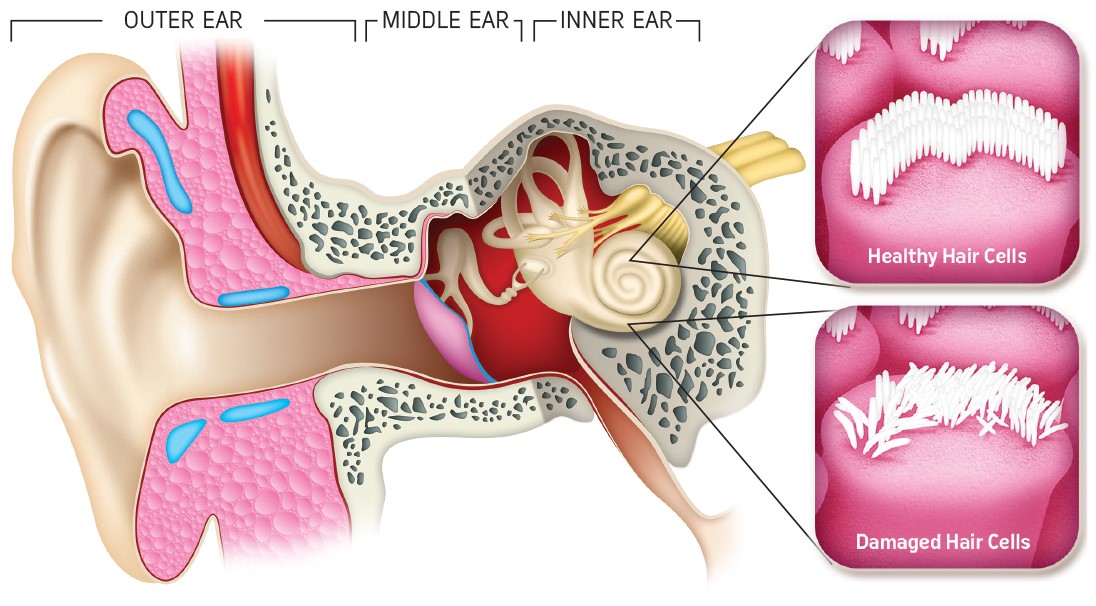Ear & Hearing
Appointment Request
Ear & Hearing
How We Hear
Ears are the organs that allow us to experience sound. They also play an important role in balance. Ears are complex and divided into three different sections: the outer ear, the middle ear and the inner ear. All three are involved in hearing but only the inner ear is responsible for balance.
All three components work together to allow us to hear as we do. The sound first enters the ear at the pinna where it is funnelled down the ear canal. The ear canal has hairs and glands that produce wax called cerumen. Cerumen keeps the ear canal moist and lubricated. Sound travels through the ear canal where it meets the tympanic membrane or eardrum.
The vibrations at the eardrum set the bones of the middle ear into motion. The three bones are called the ossicles which include the malleus, incus and stapes. These three bones are the smallest bones in the human body. The third bone, the stapes, transmits the vibrations of the middle ear to the inner ear through the stapes footplate.

The inner ear has two functions; the first is hearing and the second is balance. It is a warren of tubes filled with fluid encased within the temporal bone of the skull. The bony tubes also contain a set of cell membrane lined tubes. The bony tubes are called the bony labyrinth filled with perilymph fluid, which the membranous labyrinth tubes are filed with endolymph. This is where the cells responsible for hearing are located (the hairy cells of Corti).
The bony labyrinth itself has three sections. 1) The cochlea is responsible for hearing, 2) the semicircular canals have function associated with balance, and 3) the vestibule which connects the two and contains two more balance and equilibrium related structures, the saccule and utricle. The final structures of the inner ear are the round window and the eighth cranial nerve (cranial nerve VIII) which is composed of the vestibular nerve (balance) and the cochlear (hearing) nerve.
Role of Central Auditory Pathway in hearing and speech perception
Central Auditory Pathway plays a very important role in hearing and listening. This system is a complex network of neural pathways in the brain that is responsible for sound localization, speech understanding in noisy listening situations, and other complex auditory functions, such as music perception. The central auditory pathways extend from the medulla to the cerebral cortex. They consist of a series of nuclei (groups of nerve cell bodies in the central nervous system similar to a peripheral ganglion) connected by fibre tracts made up of their axons (processes that convey signals away from the cell bodies). This complex chain of nerve cells helps to process and relay auditory information, encoded in the form of nerve impulses, directly to the highest cerebral levels in the cortex of the brain. To some extent different properties of the auditory stimulus are conveyed along distinct parallel pathways. This method of transmission, employed by other sensory systems, provides a means for the central nervous system to analyse different properties of the single auditory stimulus, with some information processed at low levels and other information at higher levels. At lower levels of the pathway, information as to pitch, loudness, and localization of sounds is processed, and appropriate responses, such as the contraction of the intra-aural muscles, turning of the eyes and head, or movements of the body as a whole, are initiated.
Damage or impairment to any one of the above four components that make up our hearing system can contribute to hearing impairment. Hearing loss can mislead our brain with a loss of audibility and distortion in the message that is trying to reach the brain. The ears and the brain work together in a sophisticated manner to process sound and allow us to hear as we do.
Mount Waverley
(Pinewood Shopping Village)
- Level 1, 407 Blackburn Road
Mount Waverley, VIC 3149 - 03 98867157
- contact@allearshearing.com.au
- Monday: 9:00am – 5:00 pm
Tuesday: 9:00am – 5:00pm
Wednesday: 9:00am - 5:00pm
Thursday: 9:00am – 5:00 pm
Friday: 9:00am - 5:00pm
Saturday: Only on request. Weekend charges apply
Bentleigh East
- 869 Centre Road
- Bentleigh East, VIC 3165
- 03 98867157
- contact@allearshearing.com.au
- Tuesday : 10:30 am – 5 pm
Yarra Junction
- Yarra Junction Arcade
Shop 4/2456 Warburton Hwy
Yarra Junction, VIC 3797 - 03 5905 2790
- contact@allearshearing.com.au
- Hours: All days 10-5:00 pm except on Tuesday.



 View on Map
View on Map